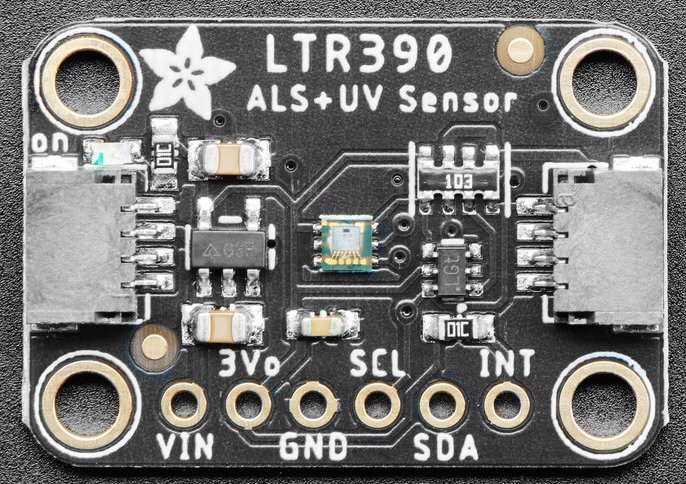LTR390 UV and Ambient Light Sensor
The ltr390 sensor platform allows you to use your LTR390 UV and ambient
light sensor
(datasheet, Adafruit_) with ESPHome.
The I²C Bus is required to be set up in your configuration for this sensor to work.

sensor:
- platform: ltr390
uv_index:
name: "UV Index"
uv:
name: "UV Sensor Counts"
light:
name: "Light"
ambient_light:
name: "Light Sensor Counts"Configuration variables
- uv_index (Optional): UV index (UVI). All options from Sensor.
- uv (Optional): Sensor counts for the UV sensor (#). All options from Sensor.
- light (Optional): Lux of ambient light (lx). All options from Sensor.
- ambient_light (Optional): Sensor counts for the Ambient light sensor (#). All options from Sensor.
- gain (Optional, string): Adjusts the sensitivity of the sensor. A larger value means higher sensitivity. Default is
"X18", see table below for options. - resolution (Optional, int): ADC resolution. Higher resolutions require longer sensor integration times. Default is
20, see table below for options. - window_correction_factor (Optional, float): Window correction factor. Use larger values when using under tinted windows. Default is
1.0, must be>= 1.0. - address (Optional, int): Manually specify the I²C address of the sensor. Default is
0x53. - update_interval (Optional, Time): The interval to check the
sensor. Defaults to
60s. It is recommended that the update interval is at least 1 second since updates can take up to 800ms when using a high resolution value.
Granular control over gain and resolution
By default, the gain and resolution parameters set same values for both ALS and UV measurements. In real life scenarios there might be significant
differences in the light intensity and UV index, so it is recommended to use different gain and resolution values for ALS and for UV sensor to avoid saturation.
See the example below, where the gain and resolution are set to different values for ALS and UV sensors.:
sensor:
- platform: ltr390
uv:
name: "UV Sensor Counts"
ambient_light:
name: "Light Sensor Counts"
gain:
ambient_light: X9
uv: X3
resolution:
ambient_light: 18
uv: 13Lux and UVI Formulas
$$ \text{lux} = \frac{0.6 \times \text{als}}{\text{gain} \times \frac{\text{int}}{100} } \times \text{wfac} $$ $$ \text{UVI} = \frac{\text{uv}}{\text{sensitivity}} \times \text{wfac} $$ where:
alsanduvare the sensor values.gainis the sensor gain, see the table below for details.intis the integration time in ms and is tied to the resolution, see the table below for details.sensitivityis the sensor’s count per UVI. See note below for details.wfacis the window correction factor.
It is recommended to use the defaults of X18 gain and resolution of 20 bits when UV Index sensing is required since
the data sheet only provides accurate conversion formula for this combination. The UVI value is linearly scaled from
this reference point when using other combinations of gain and resolution, which may be slightly inaccurate. The scaling
formula is:
$$
\text{sensitivity} = 2300 \times \frac{\text{gain}}{18} \times \frac{\text{int}}{400}
$$
where :math:2300 is the sensor count per UVI at the default configuration.
Gain
| Configuration value | gain |
|---|---|
| X1 | 1 |
| X3 | 3 |
| X6 | 6 |
| X9 | 9 |
| X18 | 18 |
Resolution
| Configuration value | Resolution (bits) | Integration Time (ms) |
|---|---|---|
| 16 | 16 | 25 |
| 17 | 17 | 50 |
| 18 | 18 | 100 |
| 19 | 19 | 200 |
| 20 | 20 | 400 |


